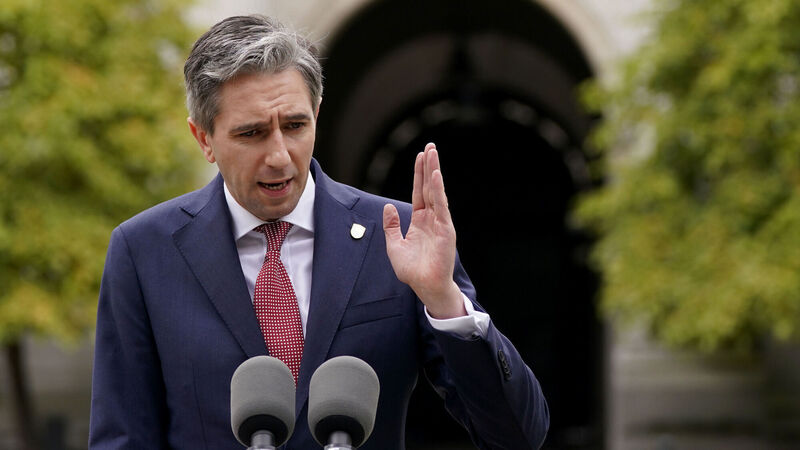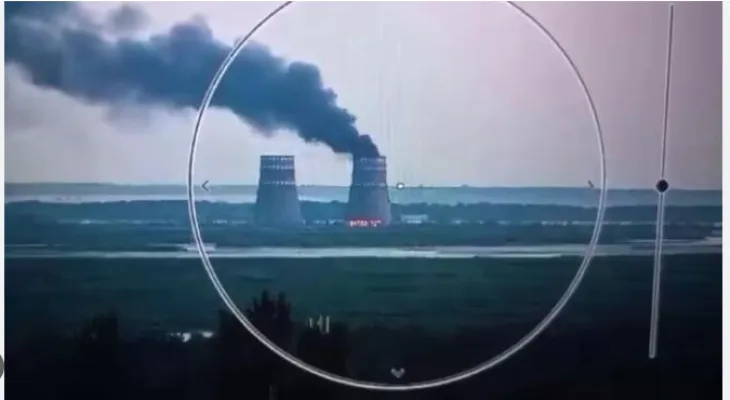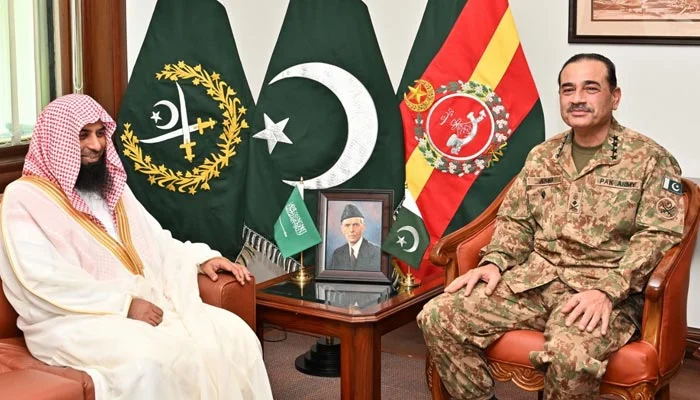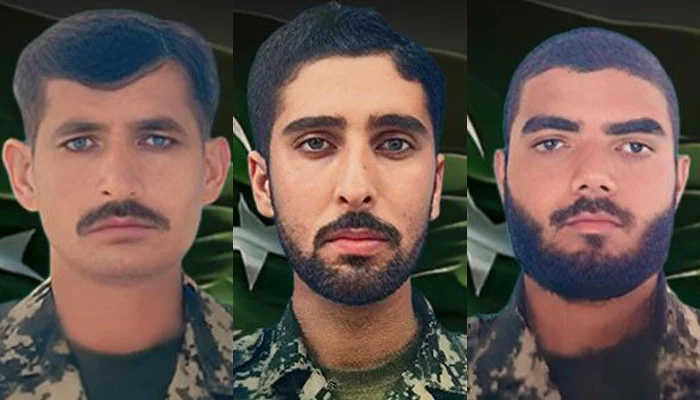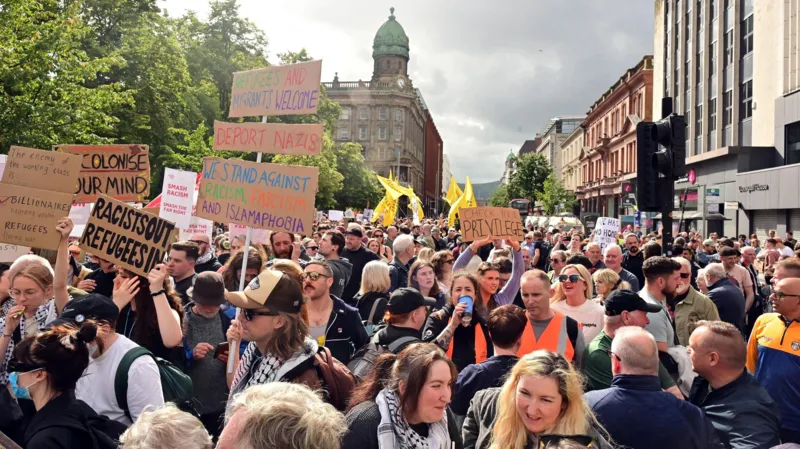Kyiv and Moscow traded blame on Sunday after a fire broke out at a cooling tower of the Zaporizhzhia nuclear power plant, under the control of Russian forces.
Ukraine, Russia and the International Atomic Energy Agency (IAEA) said there had been no detected spike in radiation levels or any impact on nuclear safety.
A Moscow-installed official, Vladimir Rogov, said the blaze at a cooling tower has been “completely extinguished” in a Telegram post Monday.
He and Yevgeny Balitsky, the Moscow-installed governor of Ukraine’s Zaporizhzhia region, blamed “Ukrainian armed forces” for the incident.
Ukrainian President Volodymyr Zelensky said in a social media post that “Russian occupiers have started a fire” at the plant, accusing them of trying to “blackmail” Kyiv.
“Currently, radiation levels are within the norm,” he added. Balitsky and the facility’s press service also reported the “radiation background” around the facility was normal.
“No impact has been reported for nuclear safety,” the IAEA, which has experts stationed at the plant, said.
“IAEA experts witnessed strong dark smoke coming from ZNPP’s northern area following multiple explosions heard in the evening,” the UN agency said in a post on social media platform X.
It said the plant had reported to them an “alleged drone attack today on one of the cooling towers”.
In a later statement, the IAEA said it had requested that its team get “immediate access to the cooling tower to assess the damage”.
Kyiv has accused Russia of purposefully starting the fire.
“Russia must be held accountable for this. Only Ukrainian control over the Zaporizhzhia nuclear power plant can guarantee a return to normalcy and complete safety,” Zelensky said.
Ukraine’s interior minister said Kyiv was “intensively monitoring” radiation levels from nearby meteorological stations.
All six of its reactors are currently in cold shutdown, the plant’s press service said after the incident.
“There is no threat of a steam explosion or any other consequences,” Balitsky said.
A video published by Zelensky showed black smoke billowing out of one of the station’s cooling towers as red flames licked around the bottom.
Russia seized control of the plant just days after it launched its full-scale military offensive in February 2022.
The site is on the eastern bank of the Dnipro river — a de facto front line snaking through southern Ukraine.
Ukraine controls the opposite bank and Russia has repeatedly accused its forces of deliberately shelling the nuclear power station — claims denied by Ukraine.
Kyiv, in turn, has accused Moscow of militarising the facility, including by placing heavy weapons there at the start of the conflict.
The IAEA has repeatedly urged restraint, saying it fears reckless military action could trigger a major nuclear accident at the plant.
Russian army concedes Ukraine advances
Moscow on Sunday acknowledged Ukrainian troops had pierced deep into the Kursk border region in an offensive that a top official in Ukraine said aimed to “destabilise” Russia and “stretch” its forces.
Later Sunday, each country blamed the other for a fire at the Zaporizhzhia nuclear plant in southern Ukraine occupied by Russian forces, though both sides — and the UN nuclear watchdog — said there was no sign of a nuclear leak.
Kyiv has deployed thousands of troops to the surprise operation, a Ukrainian security official told AFP, seizing the battlefield initiative after months of slow Russian advances across the east.
“The aim is to stretch the positions of the enemy, to inflict maximum losses and to destabilise the situation in Russia as they are unable to protect their own border,” the security official said on condition of anonymity.
The assault appeared to catch the Kremlin off guard, with Moscow’s army rushing in reserve troops, tanks, aviation, artillery and drones in a bid to quash it.
But the army on Sunday appeared to concede that Ukraine had been able to penetrate its territory by up to 30 kilometres (20 miles) in places.
In a daily briefing on the situation in the western Kursk region, the defence ministry said it had “foiled attempts” by Ukraine’s forces to “break through deep into Russian territory” using armoured vehicles.
But it said some of those forces were near the villages of Tolpino and Obshchy Kolodez, some 25 kilometres and 30 kilometres from the Russia-Ukraine border.
The Ukrainian official also said Russian claims that Kyiv had deployed 1,000 troops were a serious underestimate.
“It is a lot more,” he said. “Thousands.”
– Helicopters ‘over your head’ –
Ukrainian President Volodymyr Zelensky later blamed Russia for a fire at a cooling tower at the Zaporizhzhia nuclear plant, which Russia claimed had been caused by Ukraine shelling.
Zelensky said in a social media post that “Russian occupiers have started a fire” at the plant, accusing them of trying to “blackmail” Kyiv.
“No impact has been reported for nuclear safety,” said a statement from the International Atomic Energy Agency, which has experts at the site. Both Kyiv and Moscow said there had been no rise in radiation levels.
In a later statement, the IAEA said it had requested that its team get “immediate access to the cooling tower to assess the damage”.
A Moscow-installed official, Vladimir Rogov, said the blaze has been “completely extinguished” in a Telegram post Monday.
Russia invaded Ukraine in February 2022 and has waged an unrelenting campaign, occupying swathes of the east and south and subjecting Ukrainian cities to daily missile and drone attacks.
After re-capturing large areas in 2022, Kyiv has largely been on the back foot, struggling with manpower and arms supplies.
The assault on the Kursk region has been the largest and most successful cross-border offensive by Kyiv so far — and the most significant attack by a foreign army on Russian territory since World War II.
Russia said Saturday that more than 76,000 civilians had been evacuated from border areas, with more leaving Sunday.
Russia’s rail operator has put on emergency trains from Kursk to Moscow, around 450 kilometres away, for those looking to flee.
“It’s scary to have helicopters flying over your head all the time,” said Marina, refusing to give her surname, who arrived by train in the Russian capital on Sunday. “When it was possible to leave, I left.”
Kursk regional governor Alexei Smirnov conceded on Sunday that the situation was “difficult”.
Across the border in Ukraine’s Sumy region, from where Ukraine launched the incursion, AFP journalists on Sunday saw dozens of armoured vehicles daubed with a white triangle — the insignia apparently being used to identify Ukrainian military hardware deployed in the attack.
– ‘Taste’ of war –
Ukraine’s Sumy region has also come under retaliatory fire, and authorities there plan to evacuate some 20,000 people from the border zone.
At an evacuation centre in the regional capital of Sumy, 70-year-old retired metal worker Mykola, who had fled his village of Khotyn some 10 kilometres from the Russian border, nevertheless welcomed Ukraine’s push into Russia.
“Let’s let them find out what it’s like,” he told AFP. “They don’t understand what war is. Let them have a taste of it.”
Analysts think Kyiv may have launched the assault to try to relieve pressure on its troops in other parts of the sprawling front line.
But the Ukrainian official said: “Their pressure in the east continues, they are not pulling back troops from the area,” even if “the intensity of Russian attacks has gone down a little bit”.
Russia has announced a local state of emergency in the Kursk region, as well as a “counter-terror operation” there and in two other border regions.
The Ukrainian official said he expected Russia would “in the end” manage to stop the incursion.
Ukraine was bracing for retaliation with a large-scale missile attack, including “on decision-making centres” in Ukraine, the official added.


